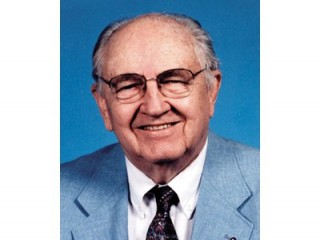
Henry M. Morris biography
Date of birth : 1918-10-06
Date of death : 2006-02-25
Birthplace : Dallas, Texas, USA
Nationality : American
Category : Arts and Entertainment
Last modified : 2011-09-08
Credited as : earth creationist, Christian apologist,
0 votes so far
Morris was born on October 6, 1918, in Dallas, Texas. As a child, he was not interested in religion. It was not until late 1930, when he was a civil engineering student at Rice University, that Morris began studying the Bible. He quickly accepted the Bible as the impeccable word of God. Morris graduated from Rice in 1939, then taught civil engineering at the school from 1942 to 1946. During this time, he became obsessed with exploring the relationship between science and religion and began examining the origins of life from both the scientific and religious viewpoints. He also continued his scientific studies, earning a master's degree and a doctoral degree in hydraulics from the University of Minnesota. Next, Morris taught at the University of Louisiana and Southern Illinois University. In 1957, Morris was named to head the civil engineering department at the Virginia Polytechnic Institute and State University.
Over the course of his lifetime, Morris wrote more than 60 books fusing scientific fact with theology. His most famous book was 1961's The Genesis Flood: The Biblical Record and its Scientific Implications . The book is considered an antithesis to Charles Darwin's Origin of Species , which argues evolution is responsible for the natural world. Co-written with theologian John C. Whitcomb, The Genesis Flood takes an academic approach to the study of religion, claiming that the Old Testament creation story is a factual account of how life on this planet began.
A central focus of the book is the Great Flood the event that, according to the Bible, prompted Noah to build the ark. Morris' book asserts that the earth's current landscape was carved out by the Great Flood, not by billions of years of erosion. The book also proposes that the earth's geological fossils and features are not the result of sedimentary rock forming over billions of years, but in fact, are the result of the flood, which caused deposits of bones and sand and rock over a several-week period following the flood. In the book, Morris also calculated the size of the ark. He wrote that it likely had a capacity of about 522 railroad cars and was capable of holding 35,000 animals enough to replenish the earth. Furthermore, the book says the creation story is true because the earth is only a few thousand years old; most scientists believe the earth is billions of years old. The book had many outspoken detractors, including Brown University biologist Kenneth R. Miller. Speaking to the Washington Post , Miller dismissed the book by saying, "They started with a conclusion Genesis and collected facts that appeared to support it, discarding or misinterpreting any that didn't fit."
Selling more than 250,000 copies, The Genesis Flood spawned the modern creationist movement and at the time of Morris' death was in its 44th printing. While mainstream scientists spurned the book's assertions, evangelical Christians used it as a rallying cry to re-spark the creationist movement. The positive feedback Morris received prompted him to gather a group of likeminded scientists and launch the Creation Research Society. Founded in 1963, the organization was devoted to finding scientific evidence to support the creation story. Morris, in fact, coined the term "creation science."
In the early 1970s, Morris moved to California and helped start the Institute for Creation Research, based in Santee. He also co-founded Christian Heritage College with Tim LaHaye, co-author of the phenomenally popular end-of-time book series titled Left Behind . Now called San Diego Christian College, the school is a scientific research organization and graduate school that offers degrees in astro-geophysics, biology, geology, and science education. The school, which fuses science and religion, has not been without critics. In 1989, the institute nearly lost its accreditation after the state Department of Education tried to shutter its doors, arguing that the school's classes were based more on religious theory than science. The institute fought the case and retained its accreditation.
Morris was a prolific author. He also wrote 1974's Scientific Creationism , 1978's That You Might Believe , 1982's Men of Science; Men of God and 1989's The Long War Against God . He was also an author of scholarly texts, such as 1963's Applied Hydraulics in Engineering , which remains a preeminent text on the subject.
During the 1980s, Morris' views received a revival as the concept of creationism gave way to intelligent design, the belief that the universe is so complex a supreme designer must be responsible. The debate over teaching the concept remains mired in the court system and continues to draw debate among school boards.
While many of Morris' ideas were dismissed by the masses, others were happy to find a likeminded theorist. As intelligent-design advocate Paul Nelson told the Los Angeles Times , "Ideas can die because there is just no one to think about them. I love the fact that Dr. Morris kept alive dissent from Darwinian evolution."
Morris died February 25, 2006, in Santee, California, after a series of strokes; he was 87. Survivors include his wife of 66 years, Mary Louise; two sons, three daughters, 17 grandchildren, and nine great-grandchildren. Another son preceded him in death.
















